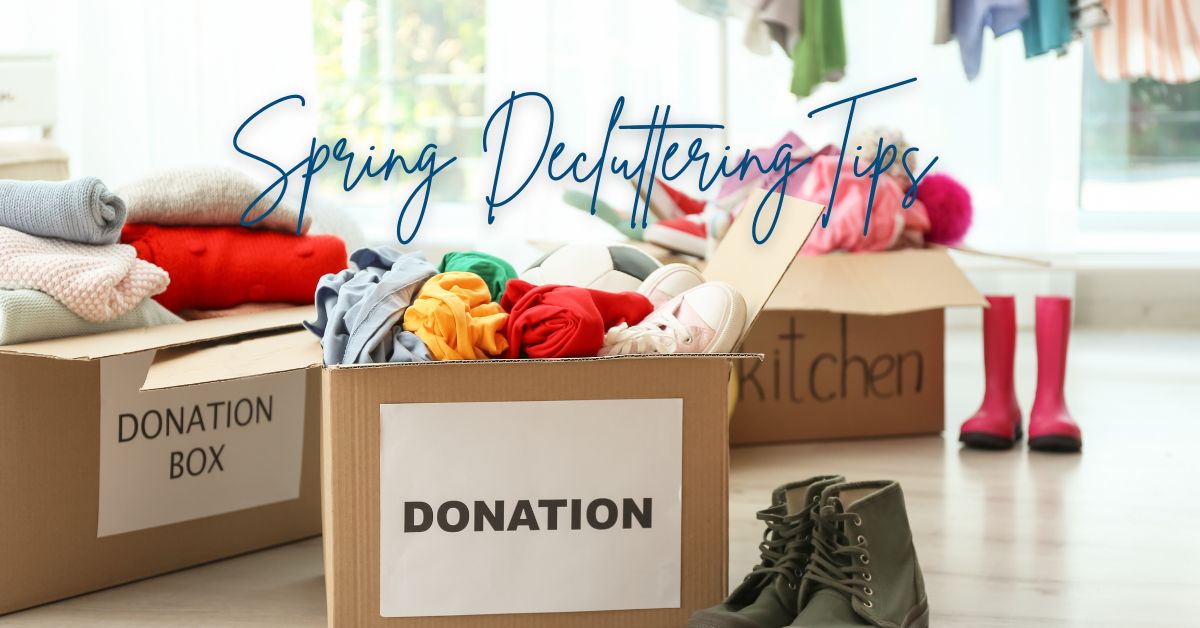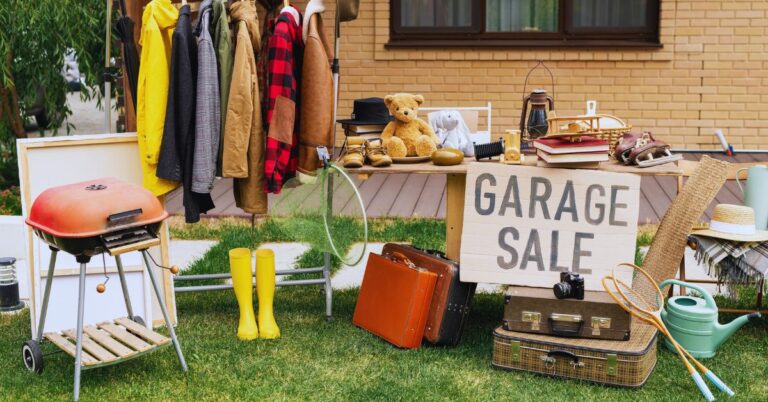How to Spring Clean and Declutter for a Fresh, Organized Home
Spring is the perfect time to hit reset and finally tackle the clutter that’s been piling up. Decluttering during your spring cleaning routine doesn’t just tidy up your home; it also clears your mind, creates more functional spaces, and sets the tone for a fresh season. Plus, there’s even a chance to make some extra cash! Once you’ve sorted through everything, consider hosting a yard sale to turn unused items into money or list valuables online to sell. After that, donate or discard anything left over.
If you’re ready to part with the clutter, check out How to Host a Successful Garage Sale and Make Extra Cash for tips to help you along the way. Let’s get started on a more organized, stress-free home!
Why Decluttering is Essential for Spring Cleaning
Before diving into your spring cleaning routine, decluttering is a must. Think of it as the foundation for everything that follows. Without first clearing out the extra stuff, you’re just cleaning around chaos instead of creating a fresh start. Whether you’re working room by room or tackling the entire home, taking the time to declutter can bring major mental and practical benefits.
Mental and Emotional Benefits
Feeling overwhelmed by the clutter in your home? You’re not alone. Piles of unused items and disorganized spaces can weigh heavily on your mind. Reducing that clutter isn’t just about aesthetics; instead, it’s about improving how you feel every single day. When your surroundings are clean and streamlined, it becomes easier to relax, focus, and feel at peace.
A clutter-free home often leads to reduced stress and a more calming environment. Imagine walking into your living room and feeling like you can breathe again. That’s the power of decluttering. Plus, tackling the mess also gives you a sense of accomplishment, like checking a box on your to-do list. Who couldn’t use that little boost of positivity?
Practical Advantages of Decluttering
Beyond the emotional perks, decluttering offers plenty of practical benefits. First off, it makes the cleaning process less overwhelming. Think about it…when you’ve already sorted through and removed what you don’t need, there’s less to dust, vacuum, and organize. It’s like clearing the path before your big cleaning spree.
Decluttering also creates more space for the things that truly matter, whether it’s functional storage or simply room to breathe. And let’s not forget: parting with unused stuff can even put money in your pocket! Once you’ve decluttered, consider hosting a yard sale for extra cash or listing valuable items online. It’s a win-win because you’ll also have fewer items to donate or throw away later. If you’re looking for tips to make your garage sale a success, check out How to Host a Successful Garage Sale and Make Extra Cash for some ideas that really work.
When it comes to spring cleaning, decluttering sets the stage for a home that’s easier to manage and enjoy all year long. So grab a box, start sorting, and get ready for a fresh, organized space you’ll love coming back to.
Room-by-Room Spring Decluttering Guide
Spring is here, and there’s no better time to refresh your home with a serious decluttering session. Tackling your home room-by-room keeps the process manageable and focused. Plus, by giving each space your attention, you’ll create a more organized and functional home that feels lighter and fresher. Let’s break it down by room so you can declutter like a pro.
Bedroom Decluttering Checklist
Your bedroom should be your sanctuary. Start by clearing out the hidden chaos under your bed. Storage bins or vacuum-sealed bags are perfect for stashing seasonal items out of sight. Next, tackle your closet. Be honest—when’s the last time you wore half of those clothes? Sort your items into three piles: keep, donate, and toss. Ask yourself for the “donate” pile if someone else could genuinely benefit from the item. Once you’ve purged your clothes, it’s easier to see what you actually enjoy wearing.
Don’t overlook nightstands. It’s easy for them to become dumping grounds for stray items like chargers, half-read books, or that random lotion you never use. Decluttering these areas makes your bedroom feel instantly calmer.
Kitchen Decluttering Tips
The kitchen is the heart of the home, but it can also be a hot spot for clutter. Start with the pantry. Toss expired food, rearrange cans so you can see everything, and consider organizing by categories like baking supplies, snacks, and canned goods. Next, take a hard look at your fridge. Leftover condiments, that ancient salad dressing? It’s time to say goodbye.
Focus on drawers (hello, dreaded junk drawer!) and organize under-sink areas where cleaning supplies often pile up. Use small containers or drawer organizers to bring some sanity to these spaces. And don’t forget, once you clear out items, you might find unused appliances or dishes. Consider selling valuable kitchen items or donating gently used ones.
Living Room Organization
Living rooms tend to collect everything from remotes to books to kids’ toys. Start with the bookshelves. Keep what you love and donate the rest to local libraries or shelters. If your entertainment system has cords everywhere, use cord organizers to streamline the mess.
Take a few minutes to declutter surfaces like coffee tables and side tables. A good rule? Only keep items you actually use or enjoy looking at. Decluttering your living room is all about creating a space where both you and your family can relax.
Bathroom Decluttering Suggestions
Small spaces like bathrooms can quickly feel overcrowded. Go through your toiletries and toss anything expired or nearly empty. That face mask you’ve had for years but never used? Let it go.
Medicine cabinets often hide outdated medications so dispose of these properly. Invest in tiered shelves or small bins for items like makeup or soaps to maximize storage. Your bathroom will feel fresh and functional with clearer counters and organized drawers.
Garage, Basement, and Attic Decluttering
These storage-heavy areas can feel like a black hole, so tackle them with a plan. Start by sorting items into categories: keep, donate, sell, and trash. Large items like furniture or equipment can often be sold for extra cash, which is perfect if you’re planning a spring garage sale. Check out How to Host a Successful Garage Sale and Make Extra Cash for tips on selling your stuff.
Use labeled bins to keep similar items together, like holiday decorations, tools, or seasonal sports equipment. A clear system makes it easier to find what you need later. And don’t forget, immediately after you declutter, be sure to donate or discard anything you couldn’t sell to avoid bringing unnecessary clutter back into your home.
Strategies for Efficient Decluttering
Decluttering may feel overwhelming, but breaking it into strategic steps can help you manage the task like a pro. A thoughtful approach turns chaos into clarity, making your home feel more functional and inviting. Whether you aim to spring clean and declutter the entire house or just a few key spaces, these strategies will keep you on track and reduce stress.
Set Realistic Goals
It’s easy to feel ambitious and want to do everything at once, but setting realistic goals is essential. Break the process down into smaller, bite-sized tasks that feel manageable. For instance, instead of tackling your whole bedroom in one afternoon, focus on just the closet or a single dresser drawer.
Ask yourself questions to set clear objectives: What do I want this space to look like? How do I want to feel when using it? These questions motivate while helping you avoid being overwhelmed. Plus, you’ll feel more accomplished as you check off those smaller tasks. After all, progress, no matter how small, adds up quickly!
Create a Decluttering Schedule
A good schedule transforms your “I’ll do it later” energy into actionable results. Start by listing all the spaces you need to tackle first, such as rooms, closets, and even the dreaded junk drawer. Then, plan specific days to work on each.
Another strategy to keep you motivated is to start with highly visual spaces to keep you motivated. Is your mudroom making you sad when you come home because it is a disaster? Start with that room first and it will motivate you to clean the next space!
Adding a checklist can make it even easier to track your progress. Checking off tasks isn’t just satisfying; it also creates measurable momentum that keeps you going. Whether you block off one weekend or spread it out over several weeks, a schedule gives structure and keeps procrastination at bay.
Once you’ve decluttered everything, it’s time to decide what stays, what goes, and what can earn you extra cash. Consider hosting a garage sale to sell unwanted items for extra money. Not sure where to start? Check out How to Host a Successful Garage Sale and Make Extra Cash for tips on keeping your sale organized and profitable.
Prioritize by Clutter Types
Not all clutter is created equal, so focusing on one category at a time can simplify the process. Start with items that are easy to part with, like old clothes or expired pantry goods. Then, gradually move to trickier things like sentimental keepsakes.
Here’s a quick breakdown of common clutter types to tackle:
- Clothing: If you haven’t worn it in the last year, it might be time to donate it.
- Papers: Sort through bills, receipts, and school papers. Shred anything sensitive you no longer need to keep.
- Toys: Get your kids involved by asking them to pick items to donate. This turns the process into a fun family project.
- Sentimental Items: These can feel the toughest. Keep only what truly brings you joy or ties to meaningful memories.
Decluttering with a Purpose: Eco-Friendly and Meaningful Steps
Decluttering doesn’t have to mean tossing everything into a trash bag. With a little thought and effort, your spring clean and declutter routine can have a ripple effect, helping the environment and others in need. Let’s explore how you can declutter with purpose and avoid unnecessary waste.
Donating and Recycling
Before you dispose of unwanted items, pause and think about their potential. Could someone else use this? Is it recyclable? Donating and recycling are powerful ways to give your old items a second chance while reducing your environmental footprint.
- Donations: Many local organizations, such as shelters, thrift stores, or community centers, happily accept gently used clothing, toys, and household goods.
- Recycling: Items like paper, glass, and electronics often have specialized recycling programs. Check with your city’s recycling center or eco-initiatives that accept e-waste like old phones or laptops.
- Creative Reuses: Sometimes, even old furniture or broken items can be upcycled. Think about donating to makerspaces or schools that might use scrap materials for projects.
Avoiding Wasteful Practices
Throwing things away might feel easier, but it’s not always the best choice for our planet or your conscience! Here are a few smart ways to reduce waste while decluttering:
- Sort Items Thoughtfully: Create designated piles for donations, recycling, and trash. Aim to keep the trash pile as small as possible.
- Opt for Sustainable Disposals: Old towels? Donate them to animal shelters. Worn-out shoes? Look for recycling programs that specifically take footwear.
- Skip Unnecessary Bags: Use reusable totes or boxes to transport items for donation or recycling. It’s a simple way to eliminate extra waste.
- Be Mindful of Electronics: Old gadgets and batteries shouldn’t be tossed in the trash. Look for e-waste drop-offs to ensure they are safely recycled.
Maintaining a Decluttered Space Year-Round
Spring cleaning and decluttering is just the beginning. Maintaining a clutter-free home doesn’t have to be a daunting chore, it’s all about building habits that stick. By committing to simple daily routines and refreshing your space each season, you can stay on top of clutter for good.
Daily Tidying Habits
Ever feel like clutter multiplies right before your eyes? Small, daily habits can make a world of difference in keeping it at bay. Instead of waiting until the mess feels overwhelming, tackle it in bite-sized chunks.
Here are a few quick ideas to keep things tidy:
- Set a timer for 10 minutes every evening: Picking up toys, papers, or stray items doesn’t have to take all night. A timed session can be surprisingly productive.
- Use the “one in, one out” rule: For every new item you bring into your home, donate, sell, or discard one you no longer use.
- Sort mail immediately: Get rid of junk mail or unnecessary papers the second they come into the house to prevent piles.
- Make your bed each morning: It sounds small, but starting your day by tidying one area creates a domino effect of order.
Quarterly Decluttering Refresh
Even with daily habits, some items slip through the cracks, but it’s totally normal! That’s why setting time aside for a seasonal decluttering session is key to keeping things under control. Think of it as your chance to reset and reassess.
Here’s how you can make quarterly decluttering work for you:
- Pick a date each season: A weekend afternoon is often all you need for a quick refresh. Tie it to a seasonal change like the arrival of spring or fall.
- Focus on problem areas: Did those junk drawers start filling back up? Is your closet bursting after a few shopping trips? Target spots that easily accumulate clutter.
- Follow the “3-pile method”: Create piles for keep, donate/sell, and toss. If you haven’t used it in six months, it might be time to let it go.
- Plan for what’s leaving: Once you’ve sorted everything, consider hosting a yard sale or sell the items online to make extra cash from valuable items.
Quarterly refreshes don’t just clear out physical space; they free up mental energy, too. Knowing you’ve got regular checkpoints to reset means you can enjoy your home without the stress of a full-on decluttering binge later.
A Fresh Start for Your Home and Mind
Spring cleaning isn’t just about clearing dust; it’s about clearing your head and making your home work for you. A thorough spring cleaning and decluttering process sets the stage for a calmer, more functional space, giving you more energy and improving your mental health.
Take that first step today. Whether you tackle a single drawer or an entire room, every small effort adds up. Your home should feel like a sanctuary, not a source of stress. Start small, stay motivated, and let this be the season you finally reclaim your space.








